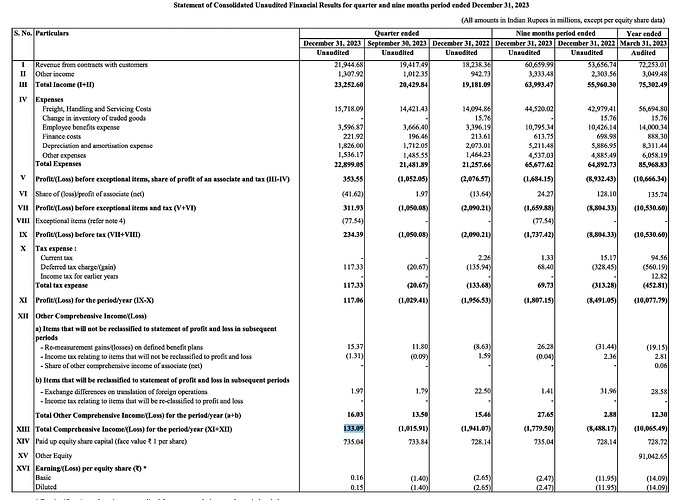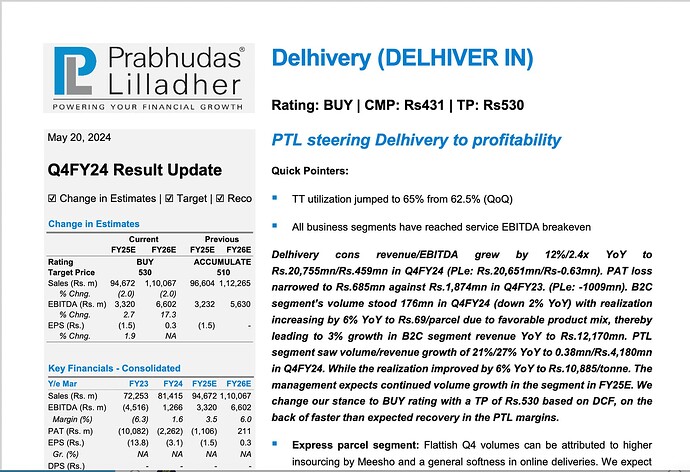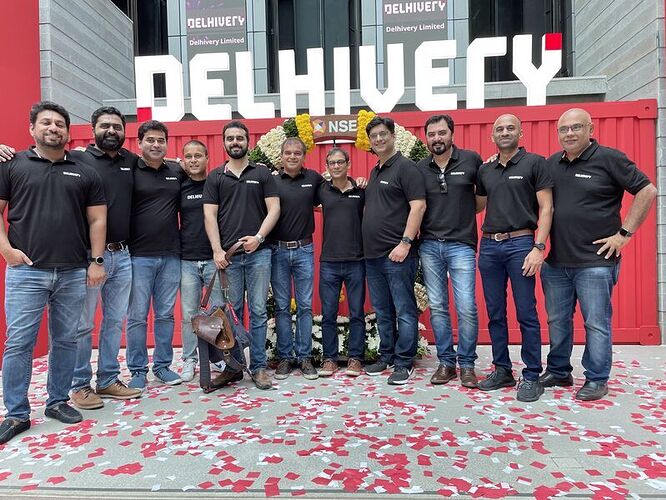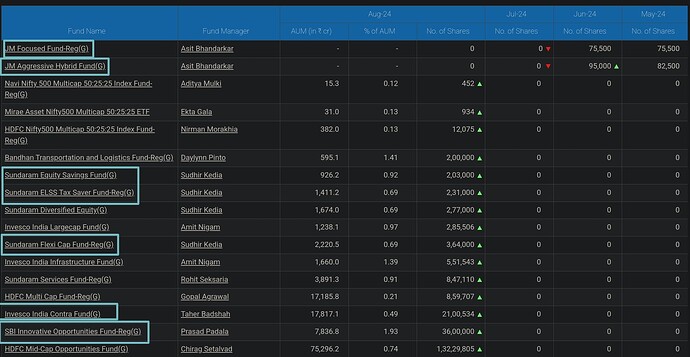Here’s the earning call transcript: https://www.bseindia.com/xml-data/corpfiling/AttachLive/be684c73-a651-4b4f-9f84-027690fee455.pdf
Sharing an important question and it’s answer which’ll help in understanding the business better
GAURAV RATERIA:
Congrats on a good set of numbers. I have a few questions, and this question I think
comes kind of, sort of every quarter on your ability to sustain very high incremental
gross margins in the transportation business. When you look at some of your
operational metrics in the last mile, such as density on a per delivery partner basis,
or a mid mile, such as the truck fill rate and sorting utilization, how do we
understand where are we versus the optimal levels? Just trying to understand the
sustenance of these incremental gross margins in the transportation business on a
going forward basis.
SAHIL BARUA:
Certainly, I think that’s a very important question, Gaurav. I’m glad you asked it.
See, incremental gross margins, as I’ve mentioned, in the past, they continue to
surprise us. You know Incremental gross margins in this quarter have also been
50%. And I’ll explain to you why it’s not very easy for us to necessarily give an
exact measure of utilization. When we did this spot-on acquisition, which was
seven quarters ago, as I’ve mentioned, we acquired it because it was integral to
growing our PTL business, providing integrated benefits to our Parcel and our PTL
customers and growing our tractor-trailer and automated gateway strategy. Now at
that point we were driving close to about 20% of our overall CFT kilometers, CFT
is a cubic foot, or if you take ton-kilometers on the tractor-trailer. And our tractortrailers were at that point about, if you look at it purely on axle weight of volume,
about 51% utilized. Now, our own numbers today suggest that we are driving close
to about 63%, 64% of our ton kilometers on the tractor-trailers. So obviously the
smaller format trucks are the ones which have lost out, which is 32-foot SXL and
MXL form factors. And utilization has increased from about 51% to about 62% or
63% in general. Now, our ability to increase utilization continues because, a) we
are densifying loads across the network, both with client selection, which is also
why we’ve been jettisoning certain kinds of clients over the last seven quarters and
also, we’re getting better at route planning and optimization. So, on average, you
know our tractor-trailers continue to drive about, if I’m not mistaken about 250,000
kms a year. And so, we find ways to utilize them better. So, it becomes a little bit
complicated. But those are some headline statistics if they help.
On the DC network, as you can see, we’ve held DC network constant at about 3,400
direct delivery stations and we continue to have about 993 partner centers. While
there isn’t a very scientific way yet for us to determine what the exact delivery
capacity of a DC is, the internal metrics are typically taken at somewhere between
about 700 and 800 packages per delivery center per day in a non-metro environment
and in the metros, we typically take DCs at between about 1,200 and 1,400
packages per DC per day. Does that mean that DCs can’t deliver more packages?
No, but typically, as an example, in a metro, if you’re trying to do 2,200
consignments in a DC, you do end up seeing a certain amount of service
degradation. Now, based on those sort of 800 and 1,200 you know thumb rules, I
would say that DC capacity utilization stands at an aggregated level somewhere at
about between 45% and 60% state by state across the non-metro network and close
to about 75% on the metro network. So, we have sufficient sort of capacity available
in the DCs, and I do not anticipate us significantly expanding the DC network in
this quarter or in the financial year to come.
On the gateway side, again, it’s a little bit of a complex question, because to give
you an example, when we started our Tauru gateway, which was the first mega
facility that we set up, it was originally set up to handle close to about 350,000 odd
freight units, a freight unit in our case is something between 15 to 20 kilograms per
box, per day. Now, when we set it up, of course, it was with an initial engineering
plan. Over the years we’ve learned how to engineer better and we’ve expanded the lifecycle of the Tauru facility. And now it’s in fact capable of going between
450,000 and 500,000 freight units a day. So, the definition of capacity sort of
expands in our network, which may make it difficult to give you an exact capacity
utilization figure at any point in time. But I can assure you it is good news because
essentially, we’re expanding capacity on existing assets, we’re learning how to use
our existing automation better and expanding the life of our larger facilities. So
tough for me to give a number. That said, I think rather than focusing on the exact
50% number, which is what we seem to have hit for the last seven quarters, I can
tell you that incremental gross margins in the network will continue to remain high,
is our view. They will of course come down at some point in time over the next
financial year. And at an overall level, we do not expect that we will have
significant expansion of infrastructure or significant expansion of the network in
fiscal '25 even if we were to look at normative sort of volume growth, which is in
the range of, let’s call it 15% to 20% for the parcel network and let’s say, even 30%
for the PTL network.
Also, sharing a question posted by me regarding the OS1 platform and it’s answer from the management:
SHIKHAR GUPTA:
Hi. Thanks for the chance. Congratulations on wonderful numbers. My question is
regarding the OS1 platform you’ve recently onboarded, Akshaya Patra. Can you
throw more light on how this business is taking shape as a global SaaS business?
And when can we see a significant revenue contribution from this business say 5%
to 10%?
SAHIL BARUA:
Sure. Shikhar, thank you for the question on OS1. We’re a little ahead of schedule.
Our plan was that in Q4 or in the early part of the next financial year, is when we
would start really operationalizing the system. Fortunately, we had this fantastic
opportunity to work with the Akshay Patra team and really deploy DispatchOne for
their kitchen-to-school delivery operations. The reason we chose Akshay Patra was
really because they are actually, interestingly enough, a significantly large logistics
operation. And so it allows us to test one at scale. The good news is, I think the tests
have been hugely positive so far, both for Delhivery and I think more importantly,
for Akshay Patra. And so now that we have testing of this at scale, there’s a lot more
confidence to go out and sell this to external customers. DispatchOne and
TransportOne, are the first two services that will be available as part of the OS1
platform. DispatchOne is a last mile delivery application which is fully
configurable for any form of shipper. So, for example, if you are a large grocery
chain which wants to offer your own delivery, you can use DispatchOne.
If you’re Akshay Patra, for example, obviously doing kitchen to school delivery,
you can use DispatchOne. If you’re a FMCG distributor and you actually want to
track delivery operations to retail, you can do that using DispatchOne. So the
number of applications is pretty significant. We’re starting to meet customers across
the FMCG pharma space in India already.
The next step for us, of course, will be to look at expanding Salesforce. This is not
a significant salesforce, of course, but a small SaaS salesforce in a couple of key
international markets. One of them obviously will be the US, since that is the largest
market from a SaaS standpoint and also where we think there’ll be significant
appreciation for the DispatchOne product. And the second will be the Middle East.
TransportOne, which is the second application, is essentially a full-fledged
transportation management system, which again, is aimed at any enterprise in the
country to manage outbound delivery operations, whether that happens through
Full Truckload or through Part Truckload. And the value proposition is that it will
be fully integrated with Orion, which is our trucking marketplace. And so
essentially shippers can simply switch on via TransportOne access to what is one
of the largest trucking marketplaces in the country. I think TransportOne monetization should begin in Q1 of fiscal '25. Now, in terms of your question,
whether 5% to 10% of a logistics company’s revenue will be SaaS revenue, if we
can build a SaaS business which is 10% of our logistics revenues, I think that would
make us the largest SaaS business in the country in five years. So that’s not
necessarily our immediate aim. I think we do anticipate starting to monetize in Q1
of fiscal '25. And we expect OS1 to slowly ramp up in revenue terms over fiscal '25
and fiscal '26.








